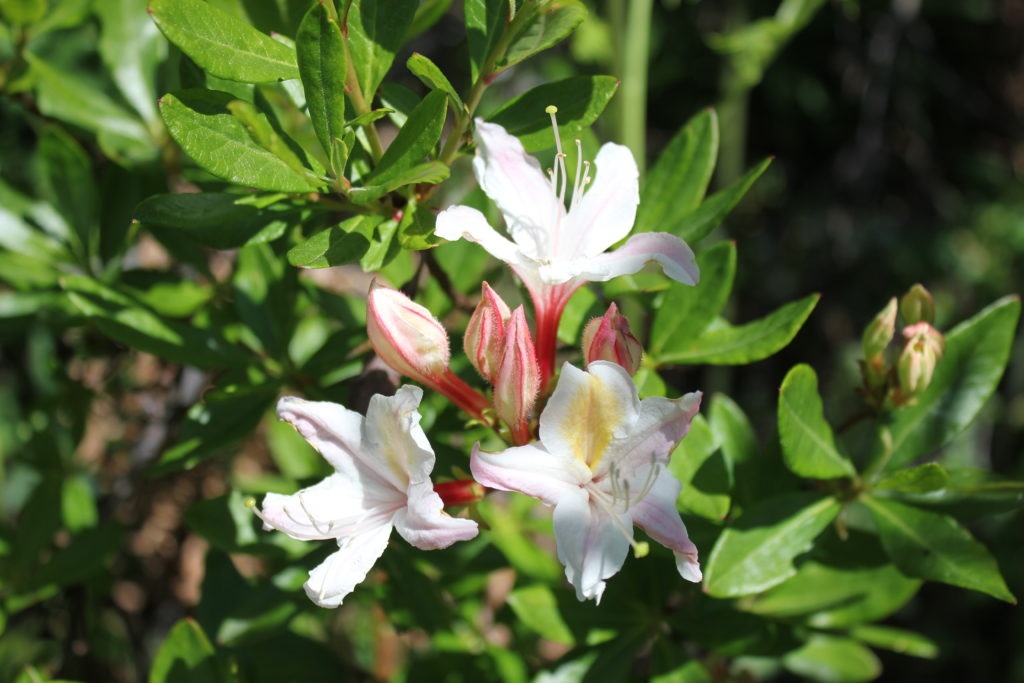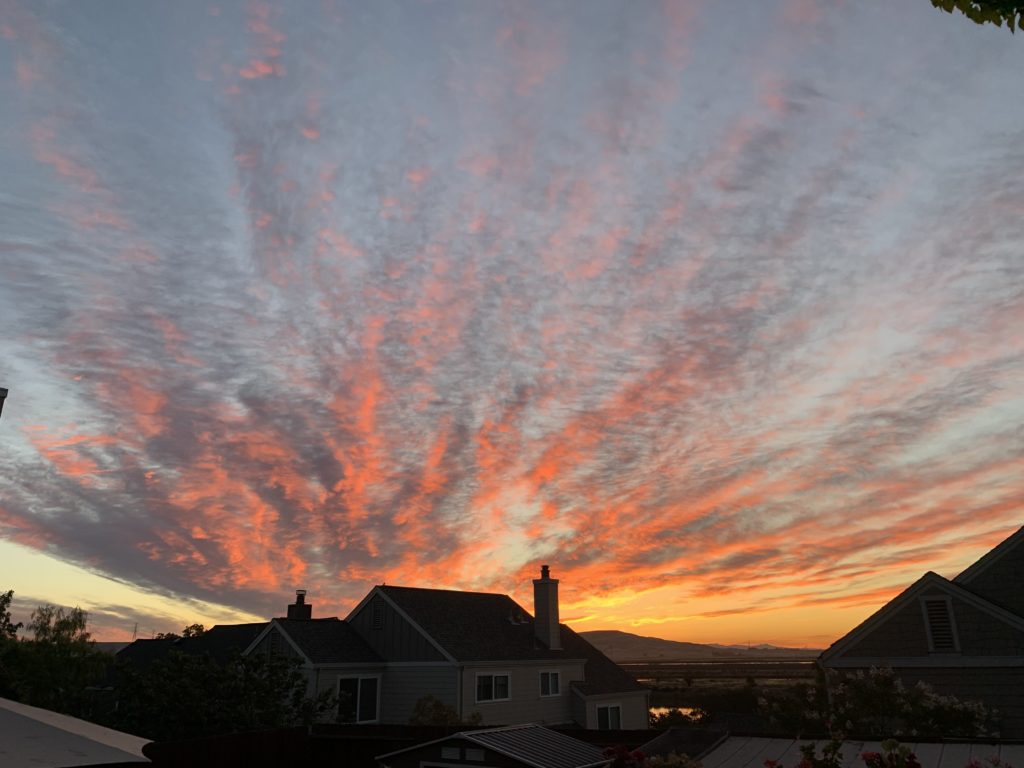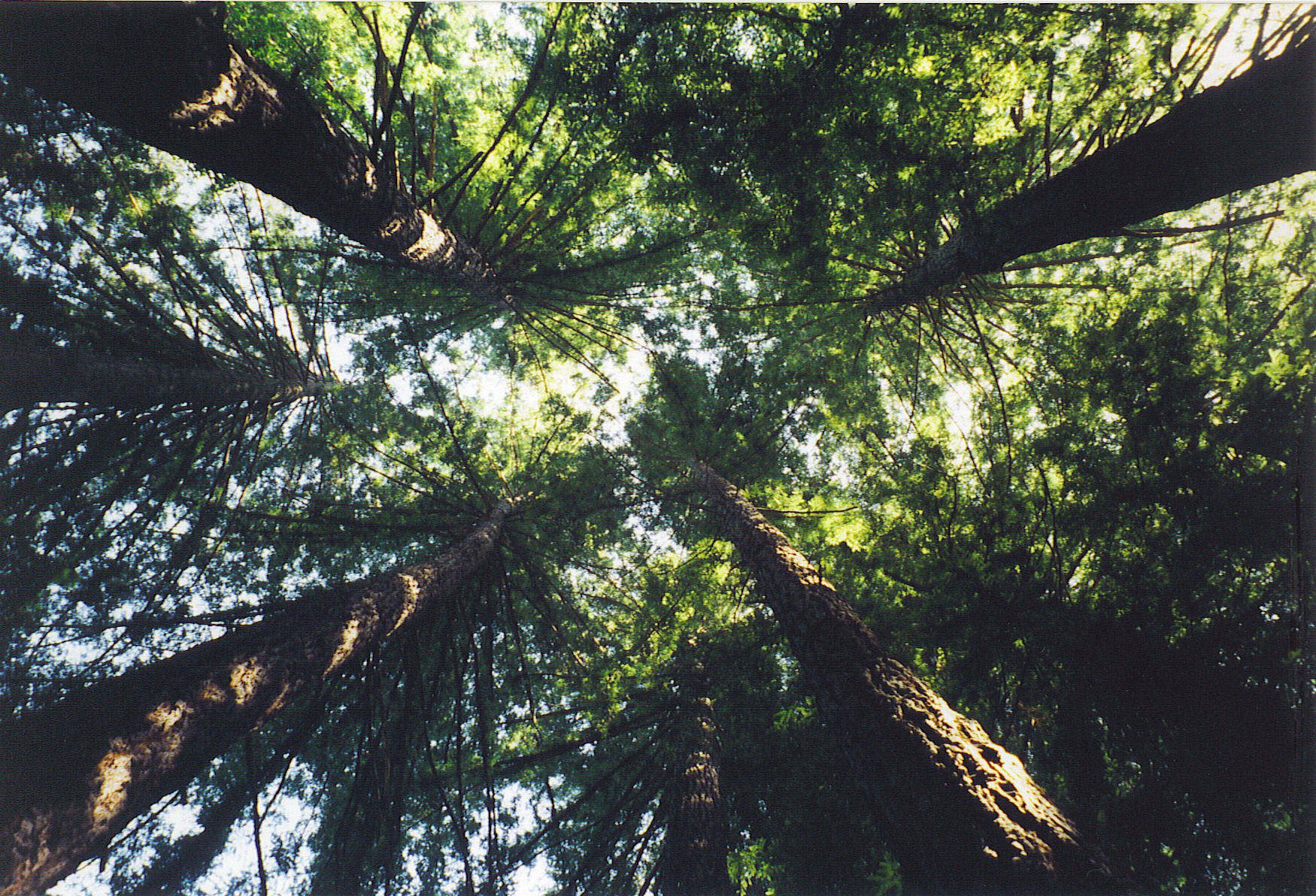“The world outside the self is indifferent to the fate of the self.”
— Barry Lopez
The horrible fire season of 2021 passed, followed by record-setting storms called “atmospheric rivers” that dumped a whole season’s worth of rain and snow on California in just two months. Meanwhile, the Corona-19 virus mutated into a new strain, and continued overwhelming hospitals and disrupting societies around the world. It seemed like nothing was routine anymore: our world just vacillated from one extreme to another.
For my birthday (just before the largest storm ever recorded on the west coast), our entire family went on a “forest bathing” experience with a guide, but in a very familiar setting: the Roy’s Redwoods grove in San Geronimo Valley. This established an immutable bond between all of us, especially the youngest ones, who instinctively appreciated the natural metaphor of an extended family of trees that helped each other weather the tempests of life.
After the storms, there followed a long dry spell for the entire month of January. Joy and I took to walking regularly: for health reasons, and to build up the strength of my legs for another Bear Lakes trip later in the year. The wetland trails and Blue Oak woods around our home are a unique and fascinating setting, quite different from the density of the redwoods. We could easily do a loop of 8-10 km, passing through twisted oaks, manzanita, bay laurel, and madrones. The understory of neon-green grass glowed in the sunshine, as the trees hesitantly peeked out their buds to see if winter was over. My legs and knees felt stronger than they had in years, and I looked forward to expanding our adventures to the many spectacular trails in Marin… and of course one in Trinity county!
Then disaster struck out of nowhere. One evening, while simply walking across our kitchen floor, my left knee “popped” with the suddenness of a rubber band snapping deep inside the joint, and a stabbing icepick of pain. I yelped in surprise, because there was no stumble, strain, or warning of any kind – just an instant of trauma that I immediately knew to be serious. I stopped and flexed my leg, bending it up and down to assess the damage, but felt nothing more. Still, I knew such a sensation could not happen without a physical cause, so I walked gingerly to test it, and it happened again! Now I was really worried, and started favoring it. It felt looser and more precarious than ever, so I got the crutches from the garage, and spent the next few days trying to determine if it would heal with rest, or if I needed to see a doctor. By the end of a painful weekend, I was convinced of the latter.
The orthopedist took x-rays, manipulated the joint, and pronounced it sound, if a little “loose” and suspect behind the knee. She pointed out the signs of osteoarthritis under my kneecap, diagnosing it as patellofemoral pain syndrome, or “runner’s knee.” That was ironic, because I hadn’t felt comfortable running in about 20 years! All things considered, it was probably the result of over-aggressive hiking on our local Bahia trails, and I was grateful to have dodged another bullet.
Six weeks later, when I still needed crutches after suffering many little “tweaks” and setbacks, I decided to push for an MRI. Something just didn’t feel right. Certainly, I had gone through this routine many times before, and was a self-contained, subjective expert in sprained knees. This time, the feeling was much deeper, and not improving with the usual treatments of “RICE” – Rest, Ice, Compression, and Elevation. I sadly resigned myself to the need for surgery on that knee again, and a lengthy rehab. However, the MRI came back without any significant problems noted: just a 3mm loose body, and moderate tendinosis. The latter affliction was congruent with the feeling of ropy muscles around my knees, and up into my thigh. I stopped taking ibuprofen, which was known to inhibit collagen regeneration, and started taking turmeric and krill oil supplements to try and improve tendon health. Meanwhile, I struggled with a persistent, irrational depression. I was so tired of having leg injuries throughout my life, and bemoaning my fate at being born with a shitty set of wheels. My melancholy was unreasonable in light of the other blessings in my life: a career and constitution that had survived the worst pandemic in a century, a beautiful home in a spectacular setting, and wonderful relationships with my dear family…even after all I had put them through. Nonetheless, I couldn’t shake the feeling of resentment that I was so often incapable of doing that one, blessed thing I enjoyed most: hiking through wild, beautiful settings. Every injury took me further away from my bliss, and closer to a restricting disability.
I needed to learn to be grateful for the many blessings in my life, and make peace with my limitations. The ancient Celts had a term for life-affirming thankfulness, known as buíochas. According to Diana Beresford-Kroeger, it means “tender gratitude,” and is also a form of self-protection. In her words, it translates in feeling to a “medicine of the mind that holds your life together.” In the modern-day vernacular of sound bites, it could be called “an attitude of gratitude.” In my stronger moments, I try to practice this wherever I go. On darker days, the shining sun of appreciation is screened by deep clouds of resentment.
but beatitude.

Three months after the initial “injury,” the knee had not improved a bit. It was still prone to sharp pain, in the same spot where I first felt it. I could not walk normally – especially on stairs. I had regulated my own care, to the point where I wore a rigid leg brace for a month, and used crutches everywhere – even in the house. I reasoned that if it was an injury, it should have healed by that time. My doctor insisted it was arthritis, as the MRI showed nothing wrong, structurally. I was getting worried that this persistent affliction could hamper my plans for backpacking. I decided to go back to strengthening exercises, but kept the brace on, just in case.
By four months, it still wasn’t getting any better, and I began looking for alternative treatments. Joy’s cousin suggested “prolotherapy,” which was common in Canada. This was a method of injecting an irritant, such as dextrose, into the knee capsule. The theory was that when the tendons and ligaments get traumatized, they would call for help. The lining of the bones would respond with molecules of collagen. This was supposed to regenerate the tissues around the knee, tightening up the structure to not only heal the injury, but prevent reoccurrence! This sounded too good to be true! I found a practitioner in Marin who took it a step further, using ozone instead of dextrose, which was less painful, but still achieved 85% successful treatment. Unfortunately, the procedure wasn’t covered by insurance, so I had to pay out of pocket. There would be 4-5 treatments needed, each about 3-4 weeks apart. That timeline would take me all the way through the summer!
During the time of the summer solstice, when I would normally be revisiting my beloved Bear Lakes, I spent an entire week flat on my back, consumed by lumbar pain. Again, there was no causal injury or action that precipitated such a debilitating condition. It felt as though the base of my spine had become detached from its pelvic moorings, and was swaying like a rotted fence post. My left knee still wasn’t getting any better, and now the right one was complaining, too. Add to that the ongoing, perplexing affliction of my right elbow, and my misery was complete. It seemed as though in the sixtieth year of my life, the house of cards that was my body completely folded in on itself. I could no longer enjoy even a short walk in our neighborhood, and had difficulty just climbing the stairs to bed. So, I stayed on the couch, alone for a whole week, while my family enjoyed a wedding and holiday in Vancouver.
I was most definitely NOT a happy camper!
I had descended to an all-too-familiar level of unhappiness, where I questioned the value of my existence. What was the meaning of a life spent mostly in debilitating pain? Others more courageous than I had endured worse conditions, but nobody in my family seemed to care very much. Not a soul reached out to me, asking how I was doing, or trying to make me more comfortable. I belittled myself into believing that nobody truly cared for my feelings, or how worried I was for my physical condition. That was how deep my depression had become. Of course, they made sympathetic noises whenever we happened to cross paths, and gave advice about what I should or shouldn’t be doing, but not a single person showed enough empathy to simply express how hard the experience must have been for me, personally. I know I didn’t deserve any sympathy after what I had put my family through, by having to share my miserable life in the first place, so I couldn’t blame them for wanting to distance themselves from my existence. But the isolation was perhaps the greatest pain, by far. All the more devastating because it was entirely my fault.
Week after week went by, and still my knee wasn’t getting any better. The pain was still there, in the exact spot where it first appeared. After four treatments of “prolozone,” however, there was a small but encouraging stability in the tendons around the joint, and a reduction in pain. I began to exercise in the community pool early in the mornings, when it was used only by old farts like me, trying to stave off death for a few more years. I hadn’t gone swimming in over 20 years, due to a lifelong discomfiture in water. I probably drowned in a former life, or something. I could swim well enough, but never really enjoyed swimming. As a result, I had rarely exercised all the muscles in my body at the same time before, and now the effort of swimming was exhausting! Even in the first few sessions, however, I could feel the activity was very beneficial, and I kept at it. Mostly, I had to build up my endurance first, so I could swim long enough to provide meaningful physical therapy for my legs.
Then, from out of the blue, another accident came; of the exasperating sort that has plagued my entire life. I woke up suddenly in bed, with a sharp pain in my knee as I changed position. In my half-awakened state, I could hear a loud, groaning noise as my twitchy leg muscles shifted the knee’s position while it was slightly out of joint. My immediate realization was that I had experienced a major setback, but I continued to turn over, as if swimming in a dream, or fighting against a current, and fell back asleep. It wasn’t until the next morning that I performed a damage assessment. It wasn’t good.
I couldn’t go down the stairs without pain, and had to revert to using the brace again, to avoid additional damage. Later in the day, my knee swelled up a little, and I knew it was another actual injury. Oddly enough, I wasn’t even upset by it. Neither was I accepting of the fact that I seemed to have the worst luck with my knees, and have experienced dozens of injuries like this for as long as I could remember. I was simply tired of reacting to yet another trauma, and automatically doing the things I needed to do: wear the brace, be extra careful in all my movements, and rest it as much as possible. Mostly, I just had to keep myself from going crazy, until sufficient time passed that I could resume trying to get strong enough to return to the Bear Lakes. This year was rapidly escaping me!
Seven months after the original “incident,” my knee still wasn’t appreciably better. I still couldn’t even go on a walk around the neighborhood; never mind backpacking. It gradually healed from the sleep injury, but wasn’t quite back to the slight improvement I’d felt a month earlier. Even more frustrating was my right elbow, which flared up painfully, and prevented me from swimming. I put my arm in a sling, and couldn’t even type or use a mouse with it! Regardless, I was determined to strengthen my legs any way I could, so I simply held on to the side of the pool and kicked, as if trying to push out the sides and make it wider. This quickly tired out my weakened legs, so I repeated the kicking in cycles, until I could barely climb out of the pool each morning.
By the time of the Equinox, I was finally starting to regain some strength. I went on my first real hike in almost eight months, with Joy, to “visit our moms” in a beautiful redwood trail in Samuel P. Taylor. The knee held up well, even during the short scramble to reach our special tree. Time was rapidly running out in the year, but I still held on to slim hopes that I might get in another October trip to the Bear Lakes. The fall colors had been spectacular in 2017, even if the nights were long and cold.
October came and went, and there was no trip to Trinity, after all. I got one final prolozone treatment, and that one really helped, along with the pool exercise. But by the time I had fully recovered from the final injection, it was already in the 30s at night, with unseasonably cold weather. It’s probably 10-15 degrees colder in the mountains, I thought glumly, as I conceded defeat for 2022, and began to look forward to next year. The pool was closed by Halloween, and my water exercises had to stop, too. My knee was still only about 60%, which meant I could walk for short distances around the house, or around the block on really good days. I was grateful to be able to walk on my own legs, but far from the physical vigor and stability required to carry 40 lbs. up the side of a mountain.
Without the pool for exercise, I halfheartedly started physical therapy at home. All through the holidays, I engaged in sporadic fits of massage and working my knee muscles, followed by long periods of torpor and depression. Time eventually healed what medical miracles or willpower could not, and my knee became strong enough to take extended walks around the lagoon near my home, or short trips in the forest. By the New Year, I was probably 75% healed, and feeling like the $1,200 spent on alternative therapies wasn’t entirely wasted.

More time-not-hiking went by, during another of the wettest winter in recent California history, when the rivers burst their banks, snow fell by the yard in the mountains, and hiking opportunities were few. Here in Bahia, our own lagunitas filled up, and the surrounding areas collected massive amounts of water, forming huge new ponds and puddles. On a blustery March day, I finally got out for my long-anticipated perambulations. Yesterday’s rain had filled all the ditches, blocking the path around the lagoons. With boyish glee for such clean, bright day, I decided to jump across one little 3-foot ditch. I landed on both feet for safety, and still it wasn’t enough. Pain shot up my right leg, and I collapsed backwards; directly into the water! It was only a foot deep, and I scrambled out quickly, but I got wet from head to foot. Nobody was around to see my graceless flop, but it must have been quite funny! I wasn’t amused myself, because my right leg suddenly wasn’t working well below the knee. Uh oh.
I knew immediately I had to get home as soon as possible. My house was a quarter mile away, but it seemed to take forever, as my feet squished with each step, and I had to place my right foot carefully to avoid the worst pain. I limped and grimaced the entire 800 steps home, with soggy clothes getting cold and clammy in the wind. My poor left leg, not yet having fully recovered from its longest injury ever, now had to do the bulk of the work. I lurched and staggered like a waterlogged zombie, hoping to make it home without any neighbors seeing me in my sorry state. Once inside, I stripped off my soaked clothes and conducted a thorough damage assessment. The pain was worst in my ankle, which was probably sprained, but it radiated all the way to my knee. This didn’t feel good at all. My fibula could be broken! The adrenaline of my death march wore off quickly, and everything below the knee hurt badly. I had no way to get to a hospital except to call an ambulance for a small fortune, or wait for Joy to get home from work. By then, it would be too late in the day for anything but the expensive emergency room. I decided to gut it out overnight, and made an appointment for the urgent care clinic the next day.
Thankfully, the x-rays were negative. It was just a high ankle sprain, but those are known for pain and slow healing. Great. Just when I was able to hike again, I was back on crutches. Even worse, my left leg was still very weak, and the knee especially wasn’t ready to support all my body weight by itself. It quickly tired, and I went from crutches to the couch. I couldn’t even get up the stairs. I was unable to walk, or even drive. And I wanted to go to the Bear Lakes in 3 months, I scolded myself. Why the hell did I jump a stupid puddle, when I could have walked 50 yards around it? When outdoors, I still had the brain of a boy, but the body of an old man. I needed to act my age, and preserve what mobility I could still get from my brittle, broken-down wagon.

Then, like the stars and planets slowly moving into alignment, the plans for my golden anniversary materialized from the cosmos. My knee was 90% healed, the ankle was fully flexible, and I could finally walk again. I felt stronger each day, and began my search for a suitable window to visit the Bear Lakes. This would be my fiftieth anniversary from the first time I visited as a mere 11-year-old. Actually, it appeared that TWO trips might come together this year, which would be a first! What a fantastic way to celebrate half a century of backpacking to the same alpine locale!
The Epps Men were itching to return, but were all leading busy lives. Dimari’s company and home projects kept him occupied seven days a week. Jordan found a coveted internship with a county agency that would further his career goals. Miles was once again absorbed in Little League and karate. Getting them all together for one week in the summer was as unlikely as training otters to march in step. It seemed early August would be the only available target, but that left another intriguing possibility on the table. In addition, the whole Epps family was going to Cancun during the week of the Fourth of July, which left open the use of their car! I could get in a solo trip while they were gone, and then return to the lakes a month later with family! These positive prospects jolted me from the torpor of infirmary and depression, and energized my outlook. I began exercising fervently on a stationary bike, and walking up our local hills to strengthen my atrophied muscles.
In my ever-brightening outlook, I compassionately surmised that it would be prudent to carry less weight up the trail. My equipment list was already pared down to the minimum ounces, which left little prospect for reducing my load when hiking alone. That left my own body, which I naturally carried around with me wherever I went. The exercise bike, combined with calisthenics and neighborhood walks, began reducing my body weight faster than jettisoning equipment ever could. I lost 10 pounds in the first 2 weeks, which was like leaving my tent, sleeping bag, and other stuff at home!
Things were looking up. I arranged for time off work, thoroughly checked all my stuff, and laid in a larder and supplies for a full 7 days in the mountains. I really needed to get away from the couch, the crutches, and the fetters of materialistic living that burdened my soul. This would be the best therapy of all, but I felt like I should lock myself in a rubber room until departure, to avoid any further injuries.

